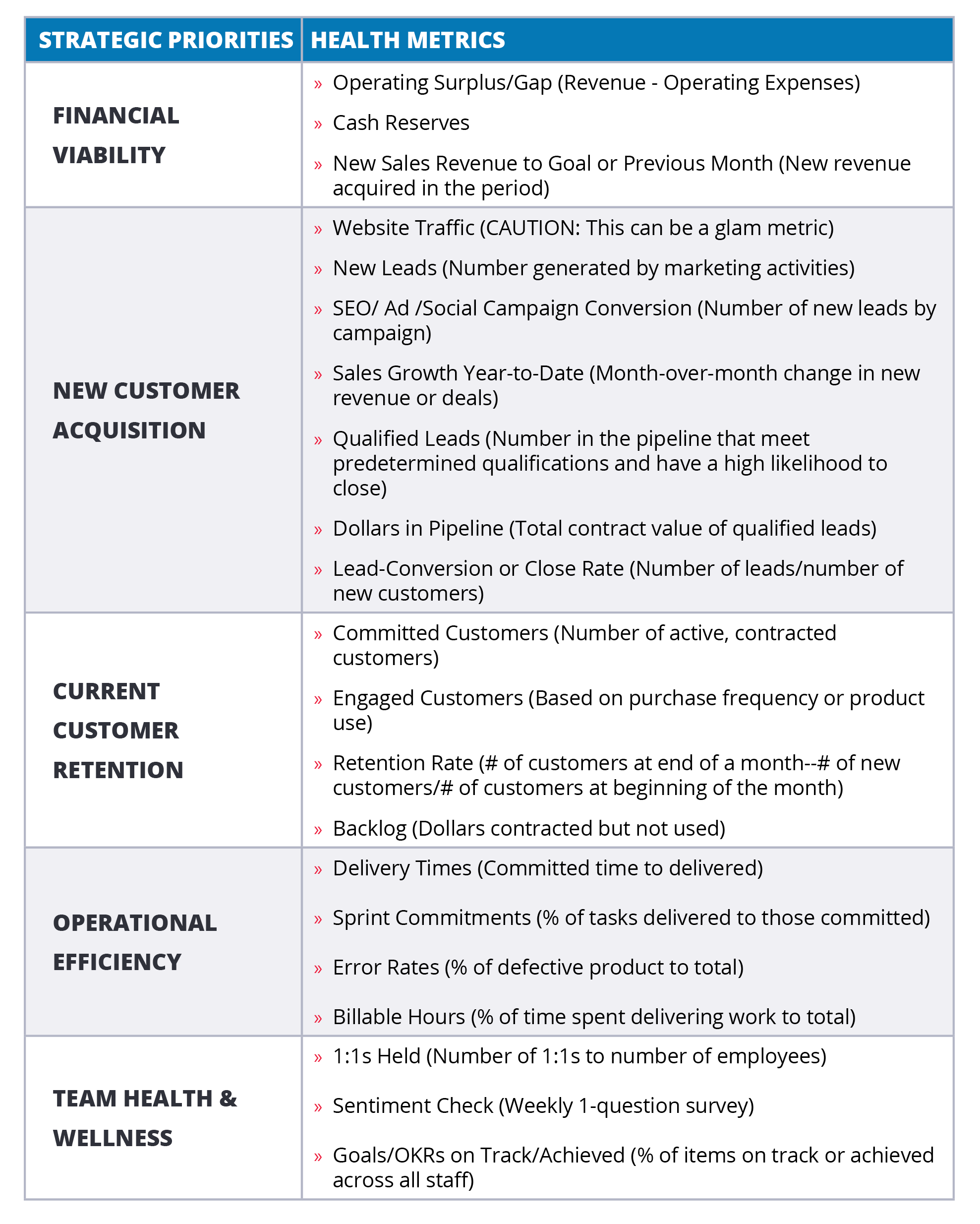How to make business health metrics your weekly heartbeat.
Gone are the days of annual planning and quarterly strategy reviews! It’s time to shift to weekly management of KPIs that keep your finger on the pulse and set your team’s priorities for the week. Imagine what your weekly team meetings would look like with results leading the conversation and action happening for the week to impact those results. Use this guide to achieve the following:
- Identify 7-10 mission-critical, leading metrics.
- Put a system and process in place to gather weekly data.
- Provide visibility to your team to align around action.
The Importance of Health Metrics
Health metrics are best described as a business’s vital signs, much like physical vital signs. With the accelerated pace of business today, it’s imperative that leaders have a regular view of indicators that tell the health and vitality of your organization. It’s particularly important in this period of uncertainty and chaos as you lead your team and set priorities. How time and resources are used is the difference between surviving and thriving. A clear set of metrics that tell you if your business is healthy or getting sick is the only way to determine what the right priorities are and what can wait.
Free Guide to Establish Your Weekly Health Metrics
Is There Difference Between Health Metrics and KPIs?
Honestly, health metrics really are key performance indicators with a twist. The twist is an important one though: Shift your focus from growth to viability. To do that, think differently in the following three aspects:
- Think mission-critical drivers instead of traditional lagging metrics. Meaning, you want to see early warning signs to allow you to take action quickly. (Example: Operational breakeven)
- Jettison target setting in favor of thresholds. Meaning, instead of putting forth an aspirational goal, you are communicating good organizational performance is staying above a threshold.
- Get rid of glam metrics. Glam metrics are those numbers that make everyone feel good, but in no way drive business performance. (Example: Facebook likes)
It’s pretty easy to fall back on the standard list of KPIs that you can find anywhere. While you probably will keep some of these in place, challenge yourself and your team to put in place data that helps you steer the business and not look in the rear view mirror.
Criteria for Effective Health Metrics & Targets
In a perfect world, health metrics meet the following criteria. Do apply these as loose guidelines instead of mandates as each business is unique and different!
- Critical, Not Nice to Have: Is critical to the viability of your organization.
- Reportable Weekly: Can be reported weekly. Monthly is ok, but most need to be weekly.
- Controllable: Your team can directly impact the number.
- Comprehensive: The set of health metrics need to align to your strategic priorities and cover all aspects of the business.
- Thresholds Instead of Targets: Based on historical performance, you know the number you must not fall below.
5 Steps to Establish Your Health Metrics & Reporting System
- Identify Metrics: Look at your current KPIs to determine which ones can be used as health metrics. Brainstorm new metrics with an eye towards the above criteria for each metric while being comprehensive.
- Clarify Calculations, Past Performance & Threshold: Document how the number is calculated, what the average past 12-month performance was and what your threshold is.
- Set Up the Data Source & Data Capture: Determine who, where and how the data will be pulled every week. TIP: Don’t worry about automation, go with manual for now.
- Land on a Reporting System: We strongly advocate for a management tool, such as the OnStrategy App, to collect the data and use it to deliver weekly dashboards.
- Report & Take Action Weekly: Stand up a weekly team review and prioritization session!
Examples
As every organization is unique, it is impossible to create a list that is all encompassing. Use the following to prompt your thinking for how you might apply these examples in your business. Here are some specific tips organized by broad strategic priority areas:
- Financial Viability: The shift here is to really look at financial metrics that indicate viability not profit creation.
- New Customer Acquisition: This is the area with the most leading metrics related to health. Steer away from glam metrics to focus on those that actually lead to new business.
- Current Customer Retention: Managing a current client base is very company specific. Work on finding metrics that you can watch weekly instead of the standard monthly metrics.
- Operational Efficiency: Remembering these are intended to be health metrics not operational stats, it’s important to just pull out those that are directly leading indicators of team and resource efficiency.
- Team Health & Wellness: Probably the hardest of the bunch to measure, consider putting new methods in place to take a temperature check of your team’s health.

Canvas to Develop Your Own Weekly Health Metrics.
Use this canvas to identify 7 weekly health metrics and outline the parameters for management.














Thanks, Hector Murry for onstrategyhq.com